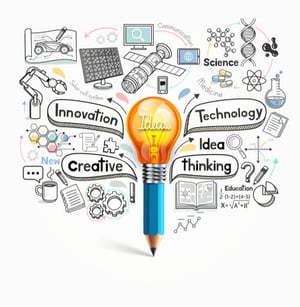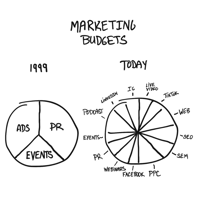Beyond Growth Mindset - You Need to Groom Challenge Driven Leaders
Introduction to SignalsFromTheOP
Guide to episode
- Growth Mindset and Challenge Driven Leadership share some commonalities, but they're different
- Disruption is creating this evolving leadership style - it's not common in traditional companies
- Challenge driven leadership will probably rub some folks in traditional businesses the wrong way
- Building a beta team internally allows companies to cultivate talent within firewalls to minimize disruption to the core business in the meantime
Transcript follows
Hi, I’m Ed Marsh. Welcome to this episode of Signals from the OP. These are periodic video blogs which I use to provide early warning like a military observation post. But rather than look for enemy sappers, here I keep an eye out for issues of potential strategic importance for B2B industrial companies.
Today’s topic is the role of growth mindset in challenge driven leadership.
Let’s start with a couple terms.
Growth Mindset
 Carole Dweck’s research led her to develop the concept and terminology of fixed vs. growth mindset. Folks with a fixed mindset tend to accept or even resign themselves to conditions about themselves, their organizations and their environment. Language they might use includes “That’s the way we’ve done it.” “If we had more resources we could do a lot more.” or even “That’s the best I can do.”
Carole Dweck’s research led her to develop the concept and terminology of fixed vs. growth mindset. Folks with a fixed mindset tend to accept or even resign themselves to conditions about themselves, their organizations and their environment. Language they might use includes “That’s the way we’ve done it.” “If we had more resources we could do a lot more.” or even “That’s the best I can do.”
In contrast, those with a growth mindset see any existing personal or organizational limitations as things to be circumvented, developed or overcome. They tend to be impatient, perhaps irreverent, optimistic and resilient.
This is a great topic that I’d recommend you dig into to understand and track among your management teams and organizations. MindsetOnline.com is a good resource.
Challenge Driven Leadership
The second core idea is challenge driven leadership. I’ve spoken often here about a modified challenger sales model - this is different and it’s based on some work by PWCs publishing group Strat & Biz. It popped up on many people's radar recently through an article in in the WSJ.
The article identifies a new type of exec that’s shaking things up.
Some of the key attributes that Strat & Biz identifies among challenge leaders are:
- They love finding and solving problems
- Hate office politics
- Bored with status quo
- Entrepreneurial
- Not interested in fancy trappings of the role
- Build team by attracting problem solvers to participate, not lots of handholding and nurturing
- Value resourcefulness
- T-shaped skills - broad high level understanding of multiple fields, and a mile deep in their own
Sound like Jeff Bezos for instance?
The key is really to develop bigger picture, longer term perspective that, as Strat& Biz says “transcends the expediencies of the moment.”
So how do the two relate? Growth mindset and challenge driven leadership?
Related but different
 It seems obvious that the challenge driven leader by definition is a growth mindset kind of person. So maybe if you had a venn diagram all challenge driven leaders would have a growth mindset, although not everyone with a growth mindset might be a challenge-driven leader.
It seems obvious that the challenge driven leader by definition is a growth mindset kind of person. So maybe if you had a venn diagram all challenge driven leaders would have a growth mindset, although not everyone with a growth mindset might be a challenge-driven leader.
This is an important point as I tie this back to strategy and disruption for industrial manufacturers.
There aren’t many existing company leaders in traditional middle market manufacturing firms that are challenge driven leaders - at least not in my experience. Those people are chasing startups and disruptive technology.
However, there are a fair number of growth mindset leaders in traditional businesses. They may feel constrained but they recognize that the constraints could be overcome with focus, investment, etc.
So when we think about how a company can prepare to avoid the challenges and leverage the opportunities of disruption, the ability to visualize much bigger challenges and opportunities becomes important. And then executing on them requires attracting the right kind of team that are equally eager to embrace and overcome problems. And those are going to be the domain of a different sort of leader in many cases - probably a challenge-driven leader.
Cultivating Talent
But if I wanted to build a lasting legacy - perhaps with an ESOP or for family to continue to participate in, then I’d be looking for a challenge driven leader.
Do you boot yourself and put them in your chair? Probably not a good move. You’d end up freaking out a lot of your traditional employees - both the personality and style, and the pace and scope of changes would be disquieting.
Build an internal beta site
But I’ve laid out a model before that could offer the perfect hybrid solution for a traditional company to begin to incorporate some of this. A skunkworks would provide a safe, contained and controlled environment to begin to experiment. Given a multi disciplinary team, an emerging challenge driven leader would operate within a framework and budget developing ideas and running pilots.
This would allow an owner to groom the talent, experiment with ideas, introduce the company to some rather different approaches, but limit the fallout in the short term.
This would position the company to do the important research, discovery, modeling and piloting that are required before rolling out very different solutions/products and services, but do it in a way that protects the core business in the interim.
It’s going to create some uncomfortable moments for sure as friction develops between impatient disrupters and conservative types. That’s going to take management savvy - and emotional intelligence that isn’t a forte of the challenge driven leader. But it’s going to be far less uncomfortable than watching competitors out disrupt them as technology and business models evolve in ways they didn’t anticipate. Like so much in life it’s a question of short term discomfort in pursuit of long term strength.
So what about installing a challenge driven leader someone in your organization and giving them room to run?
I’m Ed Marsh and thanks for joining me for this episode of Signals from the OP. If you enjoyed it, please share it and subscribe which you can do at SignalsFromTheOP.com.
Diving Deepter - Embracing Disruptive Technology and The Future of Challenge-Driven Leadership in B2B Industrial
 To understand what disruptive technologies demand of leadership, it's imperative to understand how these innovations are reshaping the landscape of B2B industrial sectors. Disruptive technology is not just about the emergence of new gadgets or software; it's about groundbreaking changes that redefine market dynamics. These technological leaps, ranging from artificial intelligence to augmented reality, are not just altering how businesses operate but are also carving out entirely new markets.
To understand what disruptive technologies demand of leadership, it's imperative to understand how these innovations are reshaping the landscape of B2B industrial sectors. Disruptive technology is not just about the emergence of new gadgets or software; it's about groundbreaking changes that redefine market dynamics. These technological leaps, ranging from artificial intelligence to augmented reality, are not just altering how businesses operate but are also carving out entirely new markets.
Companies that embrace disruptive technology will have an advantage. It will enable firms to change how industries operate.
The Influence of Disruptive Innovations on Established Companies
Established companies often find themselves at a crossroads when confronted with disruptive innovations. These companies, built around serving mainstream customers, face challenges in adapting to the fast-paced changes brought by emerging technological advances. Disruptive technologies like machine monitoring, digital technologies, and data processing are not just tools; they represent a fundamental shift in market operations and even new lines of business to be monetized. They demand a re-evaluation of existing markets and a strategic approach to engaging with demanding customers who are eager for innovative solutions.
The Emergence of New Market Segments
One of the most significant impacts of disruptive technology is the creation of entirely new markets. Technologies like machine learning and augmented reality, once seen as futuristic, are now finding practical applications across various industries. These new technologies cater to a different segment of customers, often not served by mainstream market offerings. As such, established market players must adapt or risk becoming obsolete.
This type of technology innovation is helping some manufacturers deliver significantly more value for customers.
Data Analysis and Technological Advancement in Decision Making
Data analysis has become a cornerstone in understanding and leveraging technological advancements. In the era of big data, the ability to process and analyze vast amounts of information is crucial. This data-driven approach helps companies identify new trends, understand the needs of emerging market segments, and make informed decisions about where to direct their innovation efforts.
Many industrial manufacturers are missing the opportunity to create their own proprietary data set through machine monitoring. With ai and other tools to analyze and mine the data they have an opportunity to create and monetize entirely new products and services.
The Role of Artificial Intelligence and Machine Learning
Artificial intelligence and machine learning are at the forefront of technological innovation. These technologies are not just about automating tasks; they are about providing insights that were previously unattainable. They enable companies to analyze market trends, predict customer behavior, and develop products that meet the needs of an evolving market. They can also analyze extensive data sets of machine operation which will support predictive diagnostics and other valuable insights.
Cloud Computing: A Catalyst for Innovation
Cloud computing has emerged as a pivotal technology, offering flexibility and scalability that is essential in the fast-paced world of disruptive innovations. It allows companies, especially disruptive companies, to experiment with new ideas without significant upfront investments in infrastructure. This agility is crucial for testing new concepts and quickly adapting to market changes.
Augmented Reality: Redefining Customer Experience
Augmented reality is transforming how companies interact with their customers. It offers a unique way to enhance customer experience, providing interactive and immersive ways to showcase products and services. This technology is particularly relevant for businesses looking to engage with more tech-savvy and demanding customers, and the applications for technical service and support are enormous.
The Challenge for Incumbent Competitors
For incumbent competitors, the rise of disruptive technologies poses both a threat and an opportunity. These companies must balance the need to maintain their existing customer base while exploring new technological avenues. The key is to develop a strategy that allows for incremental adoption of new technologies, ensuring a smooth transition for existing customers while capturing new market segments.
The Imperative for Continuous Innovation and Leaders Who Will Thrive
The integration of disruptive technology into B2B industrial sectors is not just a trend but a necessity for growth and survival. Companies must embrace these emerging technological advances, from artificial intelligence to augmented reality, to stay competitive. The leaders who will succeed in this evolving landscape are those who view disruptive innovation not as a challenge but as an opportunity to redefine their businesses and lead their industries into the future.


